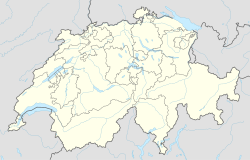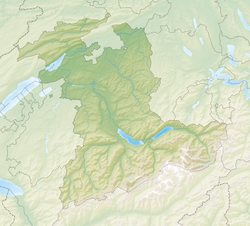Hermiswil
| Hermiswil | ||
|---|---|---|
| Former municipality of Switzerland | ||
|
||
| Coordinates: 47°9′N 7°42′E / 47.150°N 7.700°ECoordinates: 47°9′N 7°42′E / 47.150°N 7.700°E | ||
| Country | Switzerland | |
| Canton | Bern | |
| District | Oberaargau | |
| Area | ||
| • Total | 1.1 km2 (0.4 sq mi) | |
| Elevation | 494 m (1,621 ft) | |
| Population (Dec 2014) | ||
| • Total | 102 | |
| • Density | 93/km2 (240/sq mi) | |
| Postal code | 3475 | |
| SFOS number | 0978 | |
| Surrounded by | Bollodingen, Ochlenberg, Seeberg, Steinhof (SO) | |
| Website | SFSO statistics |
|
Hermiswil is a former municipality in the Oberaargau administrative district in the canton of Bern in Switzerland. On 1 January 2016 it merged into the municipality of Seeberg.
Hermiswil is first mentioned in 1289 as Hermanswile.
During the 13th and 14th Centuries, the Hermiswil area had been granted by the Kyburg family to the vom Stein family. In 1466 the city of Solothurn inherited all the vom Stein holdings, which included Hermiswil. Following the Wyniger Vertrag, of 1665, the village was given to Bern. It was placed under the authority for low justice from Bollodingen and administered by the Landvogtei of Wangen. The Roman Catholic citizens of Hermiswil were placed under the guidance of the Reformed parish of Herzogenbuchsee.
While the village is located along two transportation routes (the road from Bern into the Aargau, and since 1857 the rail line from Olten to Bern) it has remained a small farming community.
Heimiswil has an area, as of 2009[update], of 23.35 km2 (9.02 sq mi). Of this area, 14.27 km2 (5.51 sq mi) or 61.1% is used for agricultural purposes, while 7.88 km2 (3.04 sq mi) or 33.7% is forested. Of the rest of the land, 1.18 km2 (0.46 sq mi) or 5.1% is settled (buildings or roads), 0.04 km2 (9.9 acres) or 0.2% is either rivers or lakes.
Of the built up area, housing and buildings made up 3.0% and transportation infrastructure made up 1.7%. 32.6% of the total land area is heavily forested and 1.2% is covered with orchards or small clusters of trees. Of the agricultural land, 18.3% is used for growing crops and 40.7% is pastures, while 2.1% is used for orchards or vine crops. All the water in the municipality is in rivers and streams.
...
Wikipedia




